Have you just bought your first set of drums? If so, you will want to get the best from them and play them as well as possible. If you want to know how to play drums, then this post is for you. This article will cover the basic things that you need to know about drumming. Whether you are a starter or have been playing for a long time, you will find this pretty useful.
Here, you will see how you can choose the right drumkits Trusted Source Drum kit - Wikipedia A drum set is a collection of drums, cymbals and other percussion instruments, which are set up on stands to be played by a single player, with drumsticks held in both hands and the feet operating pedals that control the hi-hat cymbal and the beater for the bass drum. en.wikipedia.org for your use. We will also show you how you can learn to read music. These are but some of the things you will find out.
Learning to play drums certainly requires that you know all of the parts that make up a drum set. Some refer to it as the drum set, while some others know it as the drum kit. Regardless of what you call it, there are basic things that are common in all of them. In this guide, apart from other important stuff, we will see the main components that can get you started with your drum kit.
If you google ‘drum kit’ in a search engine, there are certain images that you will certainly see. Some of these images will include the following types of drums:
All of these combine to form the drum kit. There are numerous types of drum kits on the market, and you can determine the setup. Some can be set up for right-handed drummers, while you might also decide to switch the set up to be more comfortable for you if you are left-handed. When learning to play drums, we recommend that you learn to use the right-handed set up as it is more common, and you might find yourself needing to play it.
Now, let us discuss some of the drums that make up the set.
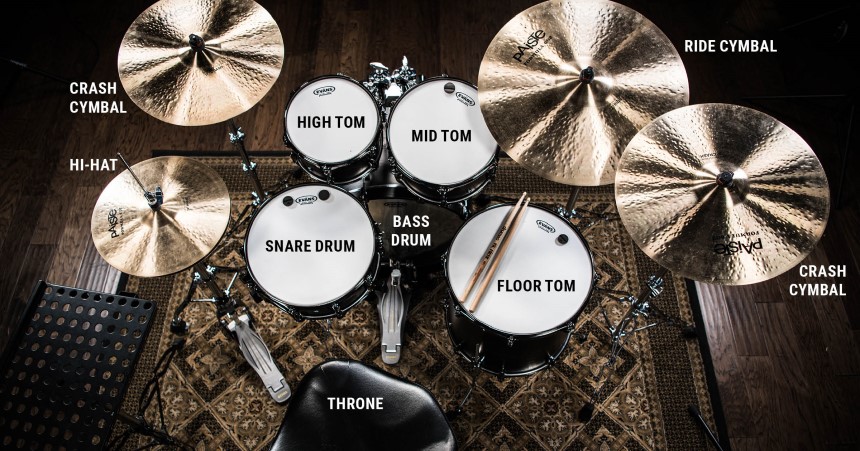 Snare Drum
Snare DrumThis is the drum that is directly opposite or in front of you. The design involves wires under the drum, and these vibrate when struck. It is these wires that give the drum its unique sound. It is adjustable as well. So if you want to change the snare sound that emanates from the drum, you can adjust the tension from the wires.
The bass drum is unique in that it is the biggest of the lot. Due to the size, it sits on the floor of the set, comes with a pair of legs to help with stability, and generally gives a big sound. It is struck by the bass drum pedal or a mallet. Most of the drummers use one pedal, but if you want quick patterns, you might decide to use a double pedal.
The tom-tom, or the tom, comes in different sizes and you might have more than one in a setup. It is particularly excellent when you are playing drum fills.
This next drum is actually a combination of cymbals. The cymbals are together on a stand and you can open and close the Hi-Hat.
We will talk about the cymbals in more detail later in this post, however, for now, it suffices to know that cymbals make up an important part of a drum set. As with the drums, they come in a wide variety of sizes and add variety to your playing. They are excellent at punctuating notes in the drum parts.
Yet another type of cymbal, this is arguably the most important type of cymbal. It is the biggest cymbal with a large surface area. It comes with a unique sound as well.
The instruments that we have listed are just some of the most important things that you need in the drum set. Apart from these, you will require drumheads too. These are available at the top and another on the bottom. They combine to provide a full sound. You will also need drumsticks to play the drums, obviously. We will discuss these later.
Cymbals are pretty important parts of any drum kit. Therefore, it is important to know how to choose them. Drummers use the cymbal to improve the sound, and they use it to add washes, patterns, and accents to the sound. As with drums, you can find them in a variety of sizes, thicknesses, and shapes. Since there are so many options on the market, you might have to try out a few to know the ones that you prefer.
This equipment is often made of bronze material. It is a durable material that gives a unique sound. The type of brass used will affect the sound and might depend on the level of the user. For beginners, their cymbals usually come made from a combination of 92% copper and 8% tin. The more expensive models, which are made for professional players, come with a different formula. This time, they come with 80% copper and 20% tin.
There are two main types of drums on the market today. These are the acoustic drums and the electronic drums. The acoustic drums are those that are traditional and what might first come to mind when you think about drums. They are traditional options that are usually made out of wood.
The electronic drums are different as they do not need the natural acoustic properties of wood. They often need an amp or headphones to be heard. Reviews indicate that the Roland TD-07KV drum kit is one of the superior options on the market. It comes with the ability to record and some of the best playability in an electronic drum kit. In this post, we focus on the acoustic models.
As we said, these are made of wood. However, you might also find models that are made from metal. In most cases, though, wood is the preferred material of construction. Some of the types of wood used include birch and maple.
Birchwood is nice because it feels lightweight, gives a punchy sound, and is relatively cheap. Maple on the other hand is warm and might be more expensive. There are other types of woods used. These include oak, walnut, and more.
Making a drum involves gluing layers of wood together and combining them into drum shells. Afterward, a rim is used to hold both ends together and is connected via rods and lugs.
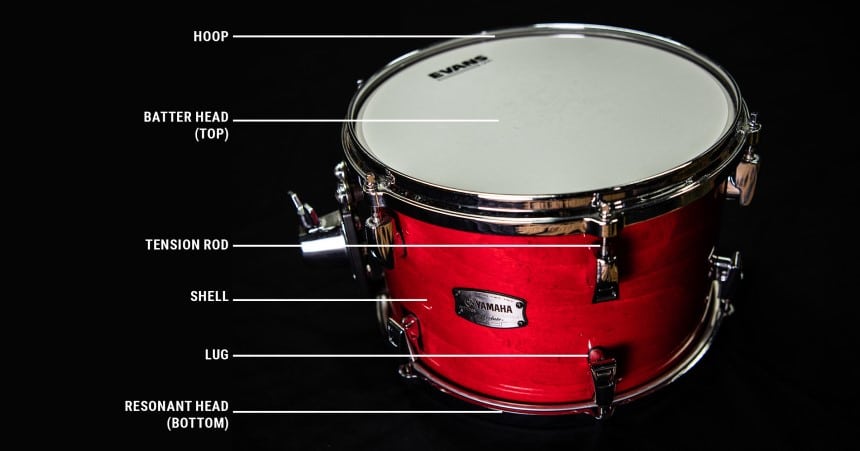 There are different parts of a drum. Some of the parts that you ought to know about include the:
There are different parts of a drum. Some of the parts that you ought to know about include the:
When choosing a drum set, one of the factors that you should consider is the brand of the drums. There are several manufacturers on the market, however, some brands are known for creating kits that are best for starters. Others focus on making drum kits for expert players.
Some of the best brands, if you are a starter include Yamaha and Pearl. These products from these brands are often cheap and easier to use. They also offer impressive durability and portability. Yamaha remains the most popular name in the music industry. Their drum sets are certainly excellent models that will ensure that you have a great time learning and playing. The reviews also consider these drum sets from Pearl to be a worthy alternative to the Yamaha models.
We do not mean that you must always buy your drum kits from popular brands. After all, some of them might not have good products but only rely on the name. You can also consider models from other brands that are not too popular. You can find good advice about these great brands and different drum sets by checking out the reviews from those that have used such drum kits.
When you are buying a drum set, you certainly have to keep an eye out for the price of the drum kit. As with all other products on the market, the kits are available in a wide range of prices. You can find cheap drum sets that cost only a few hundred dollars. Others, on the other hand, might cost thousands of dollars. There are simply several factors that will affect the cost of the drum.
Additionally, different models come with different quantities of drums in a set and the quality of individual equipment.
If you are on a budget, we recommend that you search for a used kit. This will be cheaper and will likely be of good quality.
On the other hand, if you do not want a used kit and want a new option from a good brand then you might spend up to a thousand dollars on a beginner-level kit. For a professional set, it can set you back more than $2500.
And if money is no problem, you can have the manufacturer customize kits for you.
The drumhead is an essential part of any drum. In the past, this part of the drum was made of animal skins. However, there are now different materials used for the drumheads. Some of the best options on the market today are made from Mylar. This material is a thin, relatively durable plastic.
When choosing the drum heads, you should know that there are two main distinctions – the two-ply and the single-ply. In the single ply, you have a drum head that is made up of a single layer. Two-ply options, on the other hand, are made up of two layers. Due to the two layers, they feel thicker and offer better durability.
Apart from the number of layers, you also have to decide whether you want a clear drum head or a coated drum head. If you choose the clear head, you should expect a clearer, brighter sound. The coated options will sound thicker and warmer, which can be excellent for those that want a focused type of sound.
The quality of the drum heads is also vital. Most of the drum sets that you find already have their heads. The quality of the drum set you buy will determine the quality of the heads.
When buying the drum head, you must know the size of the drum across. If you do not know this, you will likely buy a drum head that will not fit into the drum. Before you buy, measure, note the size, then look for a similar size of the head.
When buying this essential part of the drum, you should carefully observe the parts of the material. If you see that it has some dents or marks, then you might have problems with the quality of music that it will produce.
Drum heads suffer a lot during play and are often one of the first parts of the drum to wear out. Therefore, you should look to replace them frequently. You might even have multiple drum heads that you used based on what you want to play.
The drum head is so important that there are specific brands that make nothing but drum heads. Evans, Remo, and Aquarian are some of the most popular options on the market. You will discover different options in the catalog of each brand.
As a beginner, it is easy to lose yourself in the search for the perfect sound. However, do not fret about that just yet. You can actually use different drum heads and most of them will work for you as you just start.
You should know how to change the drum head, though, and fortunately for you, we highlight how you can do this later.
As these are pretty important, you should know how much it would cost to get them.
As with any other material, the cost of the drum head varies based on the factors like the build, quality, and size of the model. Nevertheless, you should find a good quality option between $15 to $15 to $80.
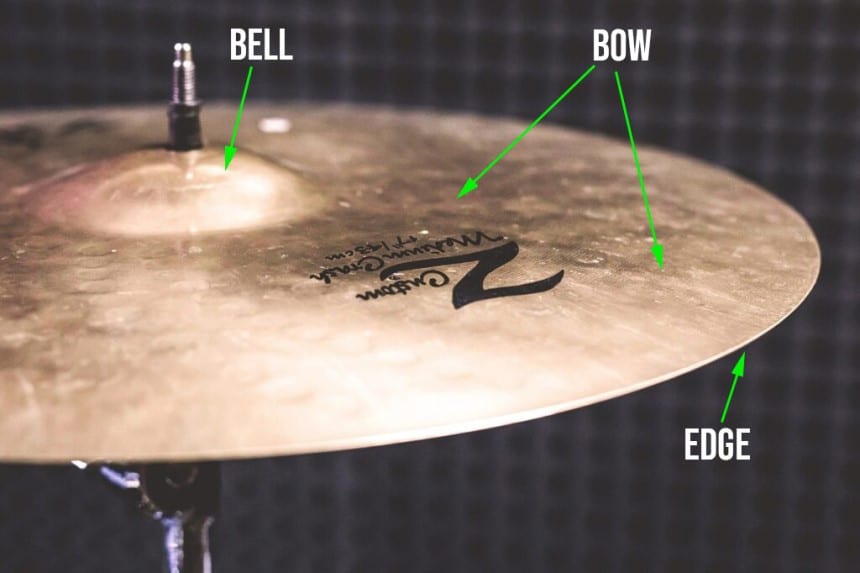 You might suppose that a cymbal is just a round plate made of bronze or brass. However, it comes with different parts.
You might suppose that a cymbal is just a round plate made of bronze or brass. However, it comes with different parts.
The parts of the cymbal are the edge, bow, and bell.
As with drums, there are different types of cymbals on the market, and if you are building your drum kit, you have to know what these different types are.
As a beginner, these are the most common types that you should look to incorporate into your first drum kit:
This has been mentioned earlier in this article. It is a combination of two cymbals that are sat in the same place. This type of cymbal is designed with a hi-hat stand and features a pedal that lets the top hi-hat to open and close when you want to play it.
The next type of cymbal is this excellent cymbal that is available in different sizes and will give a unique sound when you are playing your drum parts.
This is the biggest cymbal in your drum kit. Therefore, it comes with the largest diameter. Due to the size and lovely sound, you likely play this cymbal more consistently than the other cymbals on the drum kit.
These give a trashy crash sound and the name comes from the cymbal sounding similar in sound with Chinese tams. These are unique because of the inverted flange on the outer edge. This design is what makes drummers install them upside down on the stand.
You can find the China cymbal in different sizes. You can find small models (8″) and larger options that are as big as 20″. You will also find these cymbals in different finishes and lathing.
Because of the similar design, this might be mistaken for the China cymbal. However, it comes with differences. For one, the playing and installation method is different. Many of the players that you find install the swish like they install the crash cymbal. It is likely because it is one of the favorites to ride.
The design includes rivets around the edge of the cymbal. These even spaced rivets are excellent because they ensure that the cymbal remains active after being hit, giving it a longer sustain and improving sound.
In terms of size, this type of cymbal is one of the smallest options that you will install on the kit. If you want accents without a huge crash, then you will likely enjoy using this cymbal. The size of the cymbal ranges from 6 to 13 inches.
If you watch plenty of expert players, you will observe that many of them have multiple cymbals of this type in their kit.
It is one of the most versatile options as you can install it in several places. Some have them on drums and some play them on a snare drum. Either way, it interestingly alters the sound.
Cymbals are like drums as they are available for different prices. You can find some pretty cheap options that cost lower than $40. If you are a beginner though, we have recommendations for you. Some models are geared towards starters, and they are made from bronze.
The type of cymbal will affect the price. For instance, if you looking to buy a crash cymbal, you might spend up to $700, which might be too much for a beginner. Other types of cymbals can cost up to$650 to $750.
If you check different websites, you will find different advice on how to choose your drum equipment. Well, the reason for the disparity is that what works for Drummer A might not work for Drummer B. the qualities that a jazz drummer will look for is different from what a metal drummer might be looking for. Also, a beginner will not use the same gear as a professional. Therefore, there is hardly anything that can be qualified as the best drum equipment for a drummer.
If this is your first time, or you are moving to begin drumming, we recommend that you buy a used kit or a kit that is labeled as an entry-level kit. It will be affordable and you can change it as you get better at drumming. When you have learned to play drums, you can then move into more advanced spaces.
Apart from the size, other factors can determine the sound that the instrument gives you. We will learn all about this in this article.
The stack cymbal is a type of cymbal that has slowly grown in popularity over the years. It is even more popular now as the manufacturers have been making more options. If you love fills, driving grooves, and similar stuff, then you will love the sound of the stack.
You can create your own stack, as it doesn’t even matter the size of the cymbal. If you want heavy sounds, then you should look to buy bigger stacks.
These might appear down on the types of cymbals that there are, but it is certainly one of the best types of cymbals. While some of the types we have listed above, like the China and stack are sometimes referred to as effect cymbals, the type we are talking about here is that which comes with holes and a funky type of hammering.
Since there are so many cymbal options on the market, there really isn’t any excuse not to enjoy playing drums with cymbals on the drum kit. Knowing all of these types of cymbals will assist you in choosing the best cymbal for your drum kit.
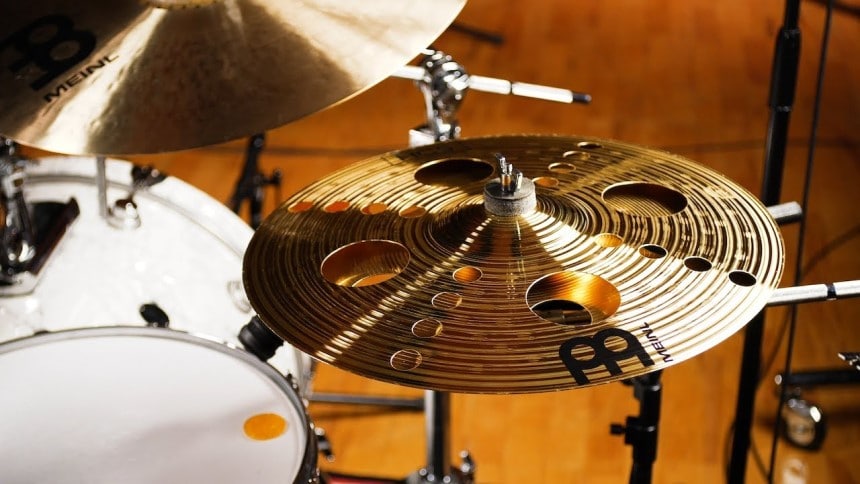 Drum Sticks
Drum SticksDrum sticks are another thing that you have to consider when choosing a drum set. Without the drum stick, you likely will not have the benefit of getting the sounds that you want.
At first glance, all drum sticks look the same. However, you will discover that there is a difference between the drumsticks on the marker. The differences found in the drumsticks affect the sound of the drum and how it feels in your hand. Before you choose a drumstick, we definitely recommend that you hold it and test it out.
There are three main parts of the drumstick. These are the tip, shoulder, and butt. You must determine how you feel about each of these parts and how they feel in your hand.
There are different sizes of drumsticks, and that is another thing that you need to consider. There are 4 main sizes of drumsticks to choose from. These include the 2B, 5B, 5A, and 7A. The smaller number will mean a bigger stick. With that in mind, a 2B drumstick will give you a bigger and thicker feel than the other numbers.
If you are a beginner, we recommend that you use the 5A or 5B options.
The length of drumsticks often stays the same and is generally the same. However, some are longer than others. Furthermore, other things like the tip of the drumstick might also vary depending on the type of drumstick.
As a beginner, few things are as exciting as buying your first drum kit. However, buying the drum kit comes with its challenges. For one, there are so many options on the market. Therefore, you might end up buying a kit that will not meet your needs. That is why you need a buying guide that will help you in choosing the best drum set for your needs.
Let’s now consider what you need to know.
As we said earlier, there are several types of drum kits on the market. And this can vary from model to model Some are expensive while others are cheap. You also have to consider the number of pieces that are found in each kit.
Some models come with a full complement of pieces, including cymbals and Hi-hats. Others are simpler and come with few drums.
Here are the things found in the kit:
If you want a more extensive setup, you might purchase one that comes with even more parts. Many drummers add cymbals to the setup.
Another thing that you must consider is the size. A drumkit can take up plenty of space, therefore, when you are setting it up, you think about the amount of space that you have. If you have roommates or live with your family, you should indicate that you will be moving a drum set inside.
If you don’t have plenty of space, it might be better if you opted for electronic models. These are usually compact and can be stored away easily. They are also great if you don’t want to disturb other people.
As a beginner, you have to get the right sound that you will identify with. Some of the things that will affect the sound include the size of the drum and the material that it is made from. If you are looking to buy an acoustic drum set, some of the materials that it might be made from include woods like maple, birch, and mahogany.
There are several things or factors that are very important if you want to choose a drumstick. In the section above, we have seen that there are different sizes of drumsticks. Other factors to consider will be discussed in this section.
One thing that you have to consider is the tip of the drumstick. Many new users wonder if the tip is really important. Well, yes, it is important. There are two main types of stick tips. These are the nylon or wood tips.
Which of them should you choose? Well, what you should use depends on the preference of the drummer and the sound you are looking for. The tips do not really make a difference when hitting the drums. Instead, the biggest difference is seen or heard, when you hit the cymbals.
If you have a drumstick with nylon tips, you will hear a clear, defined sound. The wooden tips give you an organic sound.
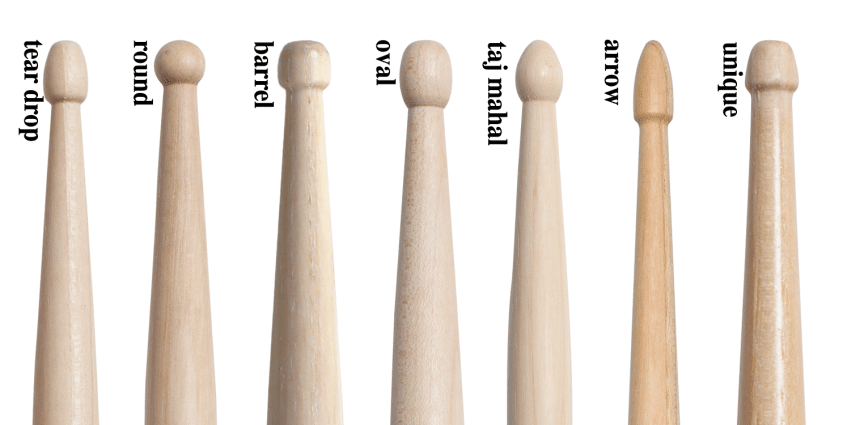 Apart from the material of the tip, you also need to consider the shape of the tip. A tip that has a small surface area will give a sharper sound. However, a bigger tip will have a warmer, full sound that you might like.
Apart from the material of the tip, you also need to consider the shape of the tip. A tip that has a small surface area will give a sharper sound. However, a bigger tip will have a warmer, full sound that you might like.
The third thing that you have to consider is the type of wood. There are different types of wood used in making the drumsticks. Hickory wood is the most popular type of wood. You can also see models that come made from polyurethane. This is a synthetic material that feels more durable.
As with the different accessories used in drum kits, you also have drumsticks from different brands. The number of dedicated makers is rather small, though. There are some popular brands that are found in most stores. Some smaller brands will give you a nice feel and sound as well.
Drumsticks are available in a wide range of prices. Generally, though, they are cheap. You can find some for as low as $5, while others might cost up to $30.
As you are just starting, you can choose something that is cheap as it will also help you to get your work done without a lot of fuss.
Some drum kits are bare-bones options, in that they might not come with some of the accessories that you need. If that is the case, you definitely need to find some of the best accessories. Which accessories are important? In this section, we will consider some of the most important extras that you should buy.
The five hardware we will now provide are the most popular and useful, but you might get some other hardware depending on what you are looking to achieve.
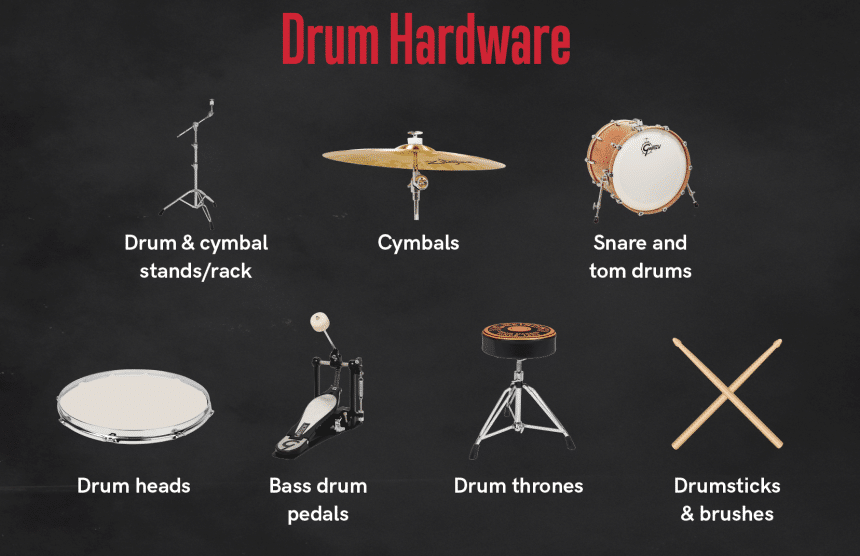 Drum Throne
Drum ThroneThis is an important accessory. It is what you will seat on while you play. There are different types of thrones. Some come with three legs while others offer more stability by coming with four legs.
They are usually adjustable and will make your playing more comfortable, especially if you are playing for a long time.
Your kit will likely include cymbals, and if there is no stand, there is no way to play these correctly. You will require a stand for each cymbal that you have. Note, though, that you don’t have to worry about getting a stand for Hi-Hats as these already come with their stand.
There are two main types of cymbal stands on the market. These are the square stand and the boom stand.
The straight stand is designed like what will hold a telescope. One disadvantage of this type is that you have limited placement options.
The boom stand will stand upward, however, the difference between it and the other is that it comes with another arm that can be extended to the side and have the cymbal close to you as you play.
Your snare drum will need a stand. If the kit does not come with the stand, then you have to get it. The stand is important because it will help you in choosing the height of the drum and the angle you play it from.
The pedal is what is connected to the bass drum. If you don’t have this, you will find it pretty hard to play the bass drum. It comes as a pedal that you push down with your legs and will strike the bass drum. The price and type determine the material that it is made of. Some of the popular materials include wood and plastic.
If your kit does not come with this hardware, you will have to buy it from somewhere, and there are brands that specialize in making excellent accessories. Some of these brands include DW and Yamaha.
If you are looking to save money, then you can check out used hardware available on the market. These are usually affordable. Since there are different hardware, the cost of each one varies. For example, thrones can cost as little as $30 to as high as $350.
The stands have different costs as well based on the type and the material used in making them.
While we have talked about some of the necessary hardware, we have left this out initially because of its importance. Drums can be pretty loud, which means that you have to protect your ears. How do you do this? By using earplugs. Earplugs offer protection from the loudest drums. With these accessories, you can preserve your hearing even if you play frequently.
That is why we recommend hi-fi silicone options that work to eliminate only dangerous frequencies while allowing you to hear the important drum sounds.
Now, another type of ear protection you might require is the over-ear plugs. You can get headphones or in-ear headphones that will protect your eardrums.
So far, we have discovered the important things about getting a drum set, the parts, and the hardware that you need. If you have all of these at hand, the next step is to set it up.
Putting all the accessories, drums, and cymbals can be tricky if you don’t know what to look out for. Well, in this section and those that follow, we will consider tips on how to set up the drums as quickly as possible while being accurate.
When setting up the kit, you should first determine whether you want to set up a right-handed kit or a left-handed kit.
Setting up the right-handed kit is easy and straightforward as long as you follow the steps provided in this section.
This is a simple way of setting up your drum kit. You can also set it up left-handed following these steps but adjusting when it is needed.
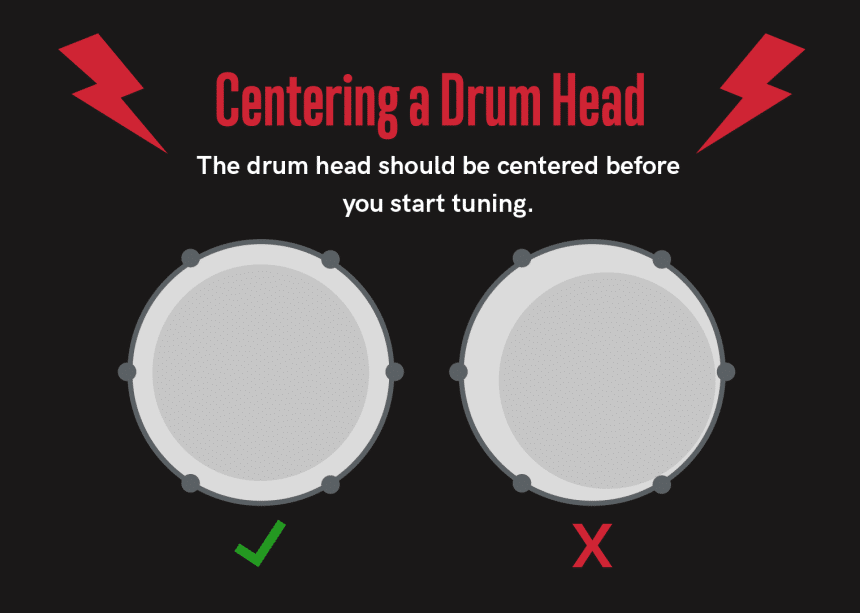 As a beginner, there are some challenges that you will face during setup. Installing the drum head is one of the hard things for many beginners. However, with the right guidance, it doesn’t have to be a big issue.
As a beginner, there are some challenges that you will face during setup. Installing the drum head is one of the hard things for many beginners. However, with the right guidance, it doesn’t have to be a big issue.
To put a drumhead successfully, you will require a drum key. The key is what will help you to change the drumhead and tune the drum. It is a tiny tool that comes with a new drum set. If you are buying a used set, you can always buy a third-party drum key.
If you have it available, then you have solved your issue with set up to a large extent. Use this tool to loosen the tension rods that are installed around the drum’s hoop. After you have loosened all of them, remove them and the hoop.
For models that have heads installed already, you can use the tool to remove the old drumhead. After removing the old head, clean the drum interior and the edges of the drum.
Then replace it with the new drumhead. Once this is in place, install the hoop and restore the tension rods that you have removed. Tighten the rods in until they feel tight.
When you hear about tuning, you likely have a piano or instrument like the guitar in mind. However, tuning also applies to drums. It is true that the drum is a rhythmic instrument, but it is unique in that you still need to tune it.
The tuning is what gives it specific sounds, and as a beginner, learning how to tune your drums is a very important thing to know how to do.
There are different ways to tune drums, depending on the drummer. However, there are some basic things that all good drummers do regardless of how they tune their drums.
Regardless of the type of drum, tuning involves tightening or loosening of the tension rods. Most of the professional drummers tune their drums by moving in a star pattern. The advantage of that is that all the rods have a full turn. After doing that, hit the drum and note the tune you get. If it is flat and muted, then you will need to tighten the rods. Another thing to keep in mind while tuning the drums is that a tuned drum has a smooth surface on the head.
Depending on the type of drum, you might find it hard or easy to tune the drum. For example, the snare drum is one of the easiest to tune. Toms are also similar in this regard.
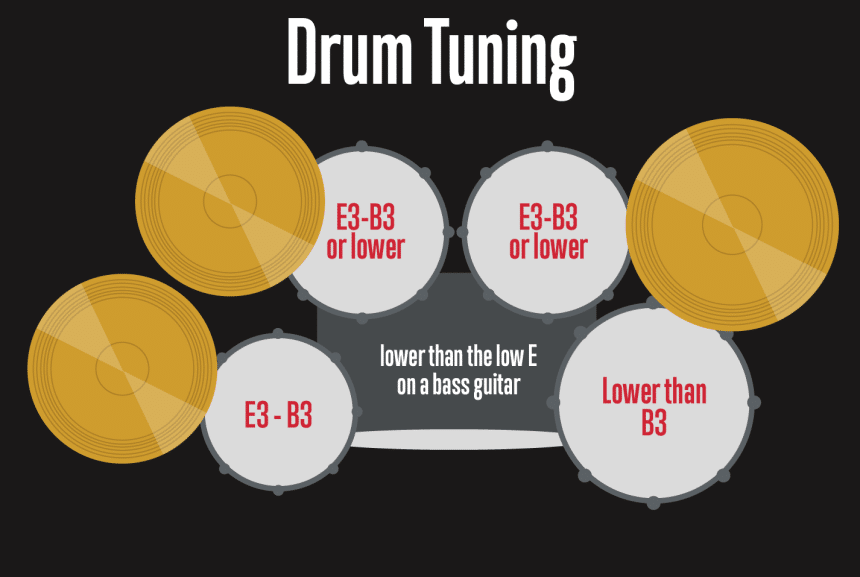
Now that you have set up the drums and have tuned them, we now move into how to play drums. To play drums, there are some important things that you must keep in mind. One of the most important things to keep in mind is counting music.
Counting music is pretty important if you want to know how to play the drums. In a band, it is important that everyone keeps time. As a drummer, you play a very important role in the band. The others in the band have you as the focus of everything. Therefore, you will serve as a metronome for them. If you have been playing music for some time, then you have learned how to count. However, counting in drums is slightly different from the regular counting that you might have learned.
Generally, four is the most important number in music, especially in clapping. Play a song and you will notice that the claps usually arrive on the quarter-note pulse. By knowing how to count the bars and quarter notes, you will have an easier time learning how to count in drumming.
A typical bar is divided into four quarter notes, so you should count the notes from the first to number four.
To have an easier time, you can count aloud. Anyway, learning to count in drumming is dependent on knowing how to read music, and that will be the focus of the next section.
The ability to read music is important, although it is possible for you to play music without knowing how to read it. In fact, many of the drummers that we have met do not know how to read charts. Instead, they instinctively feel the beats. While that is cool, it is beneficial to learn how to read music.
There are several things involved in reading sheet music, which is also known as standard notation. In this section, we consider the things that make up sheet music and how to read them.
First up is the staff. This part of sheet music is composed of lines and spaces, with each line and space denoting a different part of the drum kit. It comes in different forms, which will show that you are looking at certain instrument music. For instance, if reading sheet and you see pair of short vertical lines, then it is drum music that is indicated.
Another important thing to consider is the legend. The legend is basically what will show you the note that tallies with the drum or cymbal to be played.
Another thing to keep an eye out for is the note and rest. Each of these comes with a unique value. In some types of music, this might indicate that the note has to be held for some time. So as a drummer, all that concerns you is to know where these rests will happen.
This other important part indicates the pulses that are in the bar, as well as the duration of a single beat.
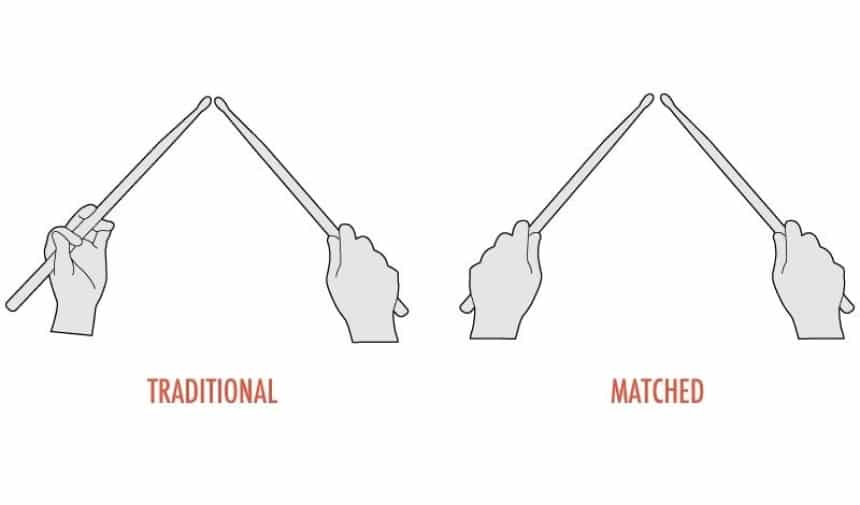 Apart from knowing how you can read music, you also have to know the right way to hold your drumsticks. There are different techniques to holding the drumsticks, and it is important to know all these as you prepare to play.
Apart from knowing how you can read music, you also have to know the right way to hold your drumsticks. There are different techniques to holding the drumsticks, and it is important to know all these as you prepare to play.
A consideration of the more popular players in the industry indicates that many of them employ the matched grip.
The matched grip is the technique of holding the sticks with both hands and have them angled downward.
Another type of grip is the traditional grip. This is a common type of grip found in jazz drumming. In this type of grip, one hand I turned up while the other is turned down. Since you are likely not a jazz drummer, the matched grip is what you should focus on.
With the right instruction, it is rather easy to get the matched grip. To start, you have to relax your hand but keep the fingers of your hand curled slightly. Imagine that you were holding a pencil. That is how you will hold the drumstick. Have the butt of the stick touching your palm.
The benefit of this type of grip is that most of the control that is required comes from the fingers. The free fingers will easily curl around the stick and give you more control. Once you have gripped it in such a way, you should turn your hand downwards.
As you hold the stick, there are some things that you should avoid. For one, you should not have the index finger pointed along the stick. Another thing that you should avoid is holding the drumstick too tightly.
When it comes to grips, there are three positions that you might adopt.
If you are looking for plenty of power, then this is the grip you should have. In this type of grip, the palms face downward.
This is a versatile type of grip that can be used for different types of drumming styles. In this method, your hands are not completely turned down.
The thumbs face upward here, and it lends to a softer stroking of the drums. It offers the most level of control that you might want.

If you are not clear on how to begin the journey of knowing how to play drums beautifully, then this section is going to make all that we have said even clearer for you. In this section, we have a systematic list on how to get ready to be a really good drummer.
As an aspiring drummer, you certainly need to have the correct equipment. One of the most important pieces of equipment is something that most people don’t even realize. What is that? Your body.
Yes, your body is an important piece of equipment. If you think about it, you will find it to be true. The only thing that allows all drummers in the world to play the drum, regardless of genre or other factors, is the body. Your feet and legs, controlled by your body, are the most important things to consider.
Away from your body, though, there are other things that are also important. For your first drumming section, you will need the right equipment. You don’t have to spend a lot of money on getting a complete drum set. You can even get one or three drums and other things to start with.
Buying in bits helps to reduce cost as you can play for some time and decide whether drumming is worth it for you.
Buying few pieces of equipment at first is you testing out the waters without fully committing yourself financially. So, how can you get the right tools?
First, look for drumsticks that are affordable. Then start hitting things and see whether you get a kick from drumming. If there is a local music store, you could also go there and play around with a drum set.
By following this advice, you can decide whether you want to be a drummer or not.
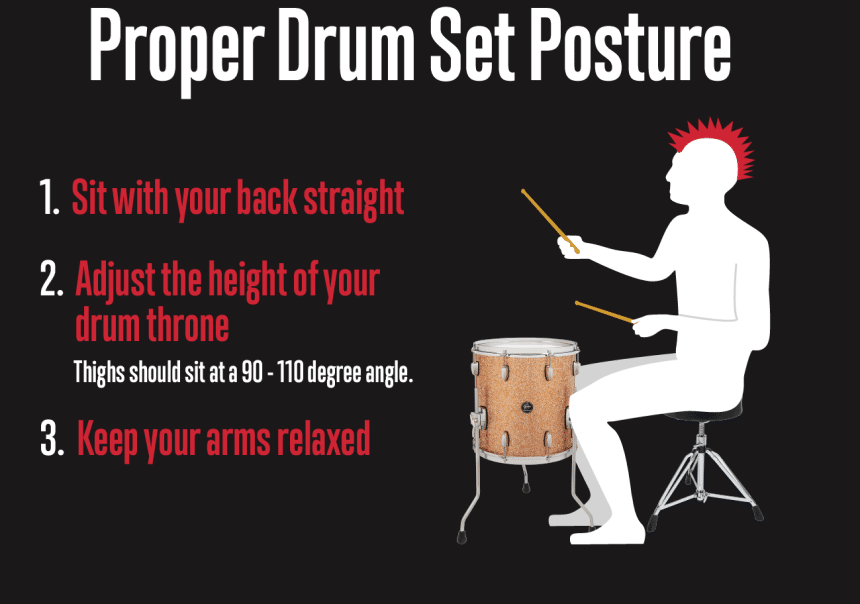 Get a Drum Set
Get a Drum SetThe moment you have likely been waiting for has now arrived – buying a drum kit. Before you move on to get an acoustic set, you might be better off with an electronic drum set. It is often compact and does not require plenty of watching over. If you like, though, you might decide you buy a drum pad. This offers you the opportunity to practice even better.
Once you have acquired the drum set, it is highly recommended that you get used to the kit. Know the different parts of the kit and what they do. In order to become pretty great at playing, you certainly need to know each part. It will also help you in properly maintaining the kit through the years. What are the parts found in the kit? You have the following:
This is the kick drum and comes as the biggest of all the drums. The shells are made of different materials, ranging from wood to metal. It is an important part of the kit and many refer to it as the pulse of the assemble.
This next piece is the center of the kit and will provide the loudest crack. It gives a unique sound that emanates from the shell.
The other parts are the toms, Hi-Hat, and cymbals, all of which have been thoroughly discussed in earlier sections of this article.
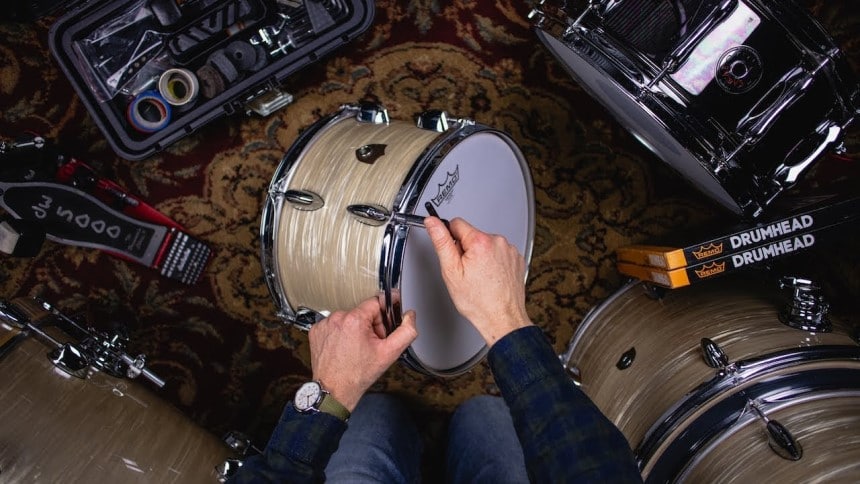 Although it is important to get the best drum set, it is equally important to keep it in shape. All the equipment must be well maintained. This includes you.
Although it is important to get the best drum set, it is equally important to keep it in shape. All the equipment must be well maintained. This includes you.
How can you take care of yourself? One of the crucial ways that you do this is by warming up before you play the drums. This involves stretching your hands, fingers, and legs. The limbs must be in the best shape to play so as to avoid any injuries.
You also have to take care of your hearing. After all, drums produce pretty loud frequencies that might damage your ear drums if you don’t do the right thing. Another thing you must do to take care of yourself is to develop good posture while playing. You don’t want to end up with a bad back because you are a drummer.
Of course, you should also care for your drum kit.
Part of this care includes cleaning the entire kit regularly. To reduce the effect of dust on the drums, you should get drum cases. These will keep the drums safe and sound when not in use. The drumheads take a lot of punishment, so it is important that you keep an eye out so that you can replace them whenever required.
You must also learn how to correctly tune your drums for the best performance.
To become a good drummer, the very best that you can be, it is important that you get someone that can show you the ropes. As a beginner, you will make mistakes and have questions, and it is up to your drumming teacher to set you on the good and narrow path.
Whether you learn online or in person, ensure that the learning program fits your needs and the budget.
If you have tried out drumming, and you feel that it is right for you, then you should think about practicing. This is done with a real drum set. Fortunately, though, you can enjoy this experience without investing in a complete drum kit.
The first thing to do, is to know how to hold the drumsticks. In this section, we will provide a step-by-step analysis on how to hold the drumsticks.
After you have learned how to hold the drumsticks, it is time to move to playing the first rhythm. While it might take some time for you to get it, once you get it, everything will feel easier for you.
Some beginners skip this part, but they end up paying for it. To do this, you should make a simple rhythm and play it repeatedly.
This is not a compulsory step, but it comes with plenty of advantages. One of the best reasons to learn how to read it is that it makes it easier for you to play with a band. You don’t have to memorize all parts of a song before you can successfully play as the drummer.
Before articles like this were available and the internet was available to most, it was pretty hard for someone to learn how to drum without making some grave errors. Thankfully, there is now a lot of help on how to drum without suffering from these errors. One way to avoid these errors is to first realize what the issues are.
In this section, we will consider some of the mistakes that new drummers make.
As a beginner, you might be pretty excited about starting your drumming session. Well, one of the mistakes that might be made in your excitement is not warming up.
The fingers, and in fact, your entire body is an extension of the drum kit. Therefore, if you are stiff and not warmed up, that can translate to your playing. Apart from affecting your playing, a failure to warm up might lead to injuries and soreness after your playing session.
Drums can be pretty loud, and if you play for extended periods, you might end up damaging your hearing later in life. Therefore, avoid the error of not wearing ear protection. As you invest in hardware for the kit, you should also invest in getting headphones or an earplug.
This has been touched earlier in this post. You must be careful about your technique, and this certainly involves how you hold the drumsticks. One of the worse ways to hold the drumsticks is holding them too tight. This can not only cause your drums to sound horrible, but it can also cause an injury to your hand.
When learning how to drum, many beginners focus only on their stronger foot or hand. While this might be good at first, it will likely affect your ability as a drummer down the line. If you ignore the weaker hand or foot, you will suffer from inconsistencies as you play. If a difficult pattern comes up, you might find yourself stuck and unable to play properly. Training with the weaker hand and foot can be a huge advantage.
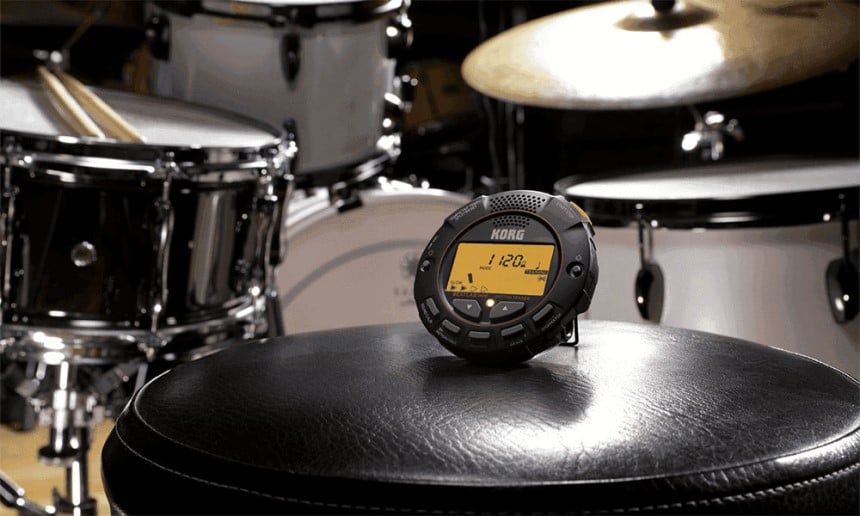 As you are human, you need a metronome to get the correct rhythm while drumming. The metronome comes in useful and will guide you in keeping to time as a beginner. You might believe you are keeping the right time, while in truth, you might not. A metronome will remove most of the guesswork and improve your accuracy. With enough practice, you will become an even better drummer over time.
As you are human, you need a metronome to get the correct rhythm while drumming. The metronome comes in useful and will guide you in keeping to time as a beginner. You might believe you are keeping the right time, while in truth, you might not. A metronome will remove most of the guesswork and improve your accuracy. With enough practice, you will become an even better drummer over time.
As a new drummer, you should know what you want to get from drumming. Are you looking to be a professional drummer or you are just learning for fun? Many beginners are stuck in a rut because they don’t have a goal. Without a goal, it is easy to lose your way and end up frustrated in your career.
It is important to practice as much as you can. You should always look to be better, but you should ensure that you have a solid grasp of the foundation before you move on to something else. Ensure that you have mastered an aspect before you move on to something else.
We have come to the end of this comprehensive guide. Playing drums can be an exhilarating experience when done right. With the right teacher, the right equipment and hardware, and with plenty of practice, you certainly can learn how to play drums. We hope that this article helps you massively as you move from being a novice to an excellent drummer.